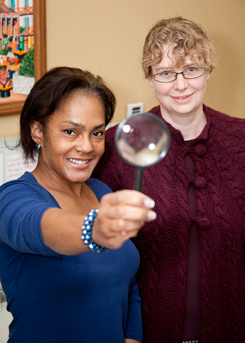Population Health
City planning and public health were the original Sherlock Holmes and Dr. Watson. Throughout the 19th and 20th centuries, they investigated and successfully intervened in health issues around the world –from diverting waste from London’s drinking water to preventing the spread of cholera.
The fields spent most of the past 200 years preventing and eradicatiing infectious disease. Now, they are tasked with a new challenge: ending the rise of chronic disease.
“Today chronic diseases like obesity, heart disease, and diabetes are leading causes of death,” said Dr. Gaynor Watson-Creed, Medical Officer of Health for Capital Health.
Recently, Public Health Services produced its first Population Health Status Report and it shows chronic health issues are present in the Capital Health district. Their prominence also varies by neighbourhood and levels of deprivation.
In studying the report’s findings, Public Health is left with questions: Why the high levels of chronic disease, and why the neighbourhood disparities?
“Why, for example, are 60 per cent of Capital residents overweight or obese and why are some communities particularly likely to weigh more than others?” Dr. Watson-Creed asked.
Like all important detective work, the question is just the beginning.
“These results are a starting point for more surveillance and research that, we hope, will eventually lead to developing policies, programs and other targeted interventions at a geographic, neighbourhood level.”
Some work currently underway by Halifax Regional Municipality (HRM), like the Complete Streets Project and the development of new community design guidelines, may help jumpstart interventions.
Both are part of a Healthy Canada by Design funded project lead by the Coalition Linking Action and Science Prevention (CLASP).
Ali Shaver, Public Health’s CLASP facilitator, works as liaison between Public Health and HRM’s city planners and engineers.
“The design of the built environment has a big impact on our health,” said Shaver. “Sidewalks and parks, bike lanes, healthy food options like farmers markets and urban gardens, and safe spaces that let you get outside and meet your neighbours – all of these have positive health benefits.”
Shaver explains the goal of the Complete Streets Project, part of the draft regional plan currently before council, is to help HRM create roadways designed for the safety and comfort of people of all ages, modes and abilities.
The new design guidelines take the Complete Streets idea further by giving HRM a tool to review developers’ community plans and determine where the city can incorporate healthier design.
"It's a new way of thinking," said Shaver. "Designing streets, prioritizing active transportation, gives people more options to include physical activity in their daily lives. The idea of the new guidelines is to ensure new neighbourhoods have better access to grocery stores, libraries or green spaces, and that developers build shorter blocks that are friendly to walkers.”
Halifax mayor Mike Savage supports the projects.
“We are working to build healthy, livable community,” he said. “By collaborating with Public Health, we can improve our understanding of how community design contributes to the well-being and quality of life of residents.”
The Population Health Status Report and CLASP’s work are bringing the relationship shared by public health and city planning back to the forefront of community building.
“When it comes to our health, geography matters,” said Dr. Watston-Creed. “By better understanding the health of Capital’s communities and how it is influenced by the environments we built, we can take deliberate actions to encourage a future without chronic disease.”

From left, Dr. Gaynor Wastson-Creed and Dr. Robin Taylor, medical officers of health for the Capital Health region.